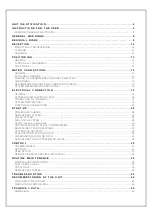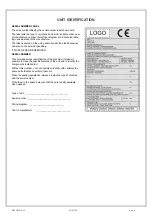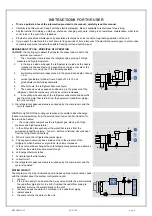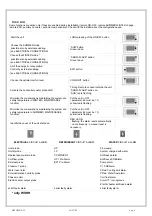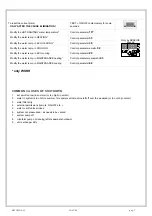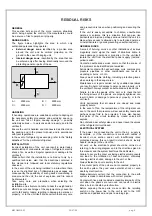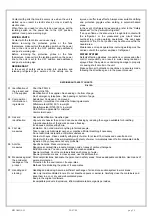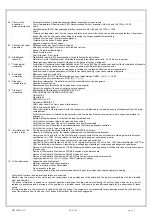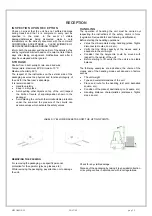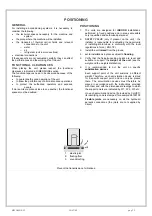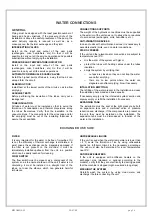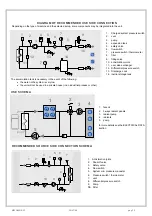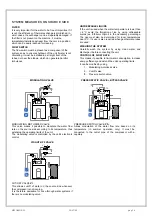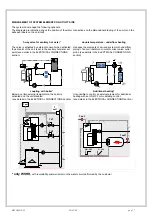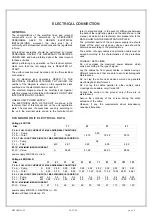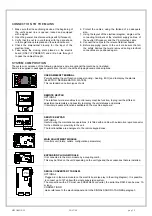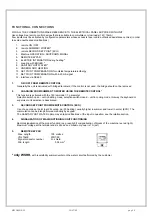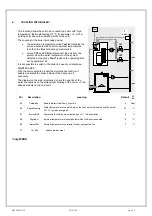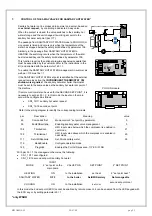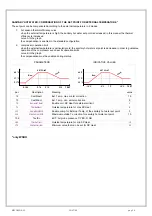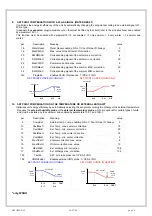
M03Q40G6-03 30/07/08
pag
11
08 Check of the
exposition /
personal protection
Personal protection. Assure adequate ventilation, especially in closed rooms.
Control parameters. Difluorometan (R32): Recommended limits of exposition: AEL (8h and 12h TWA) = 1000
ml/m3
Pentafluoroetan (R125): Recommended limits of exposition: AEL (8h and 12h TWA) = 1000
ml/m3
Protection of respiratory tract. For the rescue and for service work in the tanks, use an autonomous breather. Vapours are
heavier than the air and can cause choking by reducing the oxygen available for breathing.
Protection for the eyes. Total protection glasses.
Protection for the hands. Rubber gloves.
Hygienic measures. Do not smoke.
09 Chemical
-physical
properties.
Relative density, gas (air=1) Heavier than air.
Solubility in water (mg/l). Not known, but probably very low.
Aspect. Colourless liquefied gas.
Smell. Simile to ether.
Point of ignition. Don’t ignite.
10 Stability
and
reactivity.
Stability and reactivity. No decomposition if used following the instructions.
Materials to avoid. Alkaline metals, earth alkaline metals, granulated metal salts, Al, Zn, Be etc. in powder.
Dangerous decomposition products. Halogen acids, traces of carbonyl halogens.
11 Toxicological
information
Local effects. Concentration substantially above the TLV value (1000 ppm) can cause narcotic effects. Inhalation of products
at high concentration decomposition can cause respiratory insufficiency (pulmonary edema).
Long-term toxicity. It has shown no carcinogenic, teratogen or mutagenic effects on animal experiments.
Specific effects. A rapid evaporation of the liquid can cause freezing. It can cause cardiac arrhythmia.
12 Ecological
information
Effects connected to ecotoxicity
Pentafluoroetan (R125) Potential of global heating of halocarbides; HGWP; (R-11 = 1) = 0.84
Potential of ozone impoverishment; ODP; (R-11 = 1) = 0
13 Disposal
considerations
General considerations. Do not drain where the accumulation can be dangerous
Usable as reconditioning.
Depressurized containers should be given back to the supplier.
Contact the supplier if the use of instructions is necessary.
14 Transport
information
Designation for the transport LIQUEFIED GAS N.A.S
(DIFLUOROMETAN, PENTAFLUOROETAN)
UN No 3163
Class/Div 2.2
ADR /RID Nr 2, 2°A
No hazard ADR/RID 20
ADR Label. Label 2: not toxic gas not inflammable.
CEFIC Groupcard 20g39 - A
Other information for the transport. Avoid the transport on vehicles where the loading zone is not separated from the driver
compartment.
Verify that the driver is informed on the potential risk of the load and that he knows what to do in case of an accident or
emergency.
Before starting the transport, verify that the load is well fixed and:
Verify that the container valve is closed and does not leak
Verify that the blind cap of the valve, if supplied, is correctly assembled.
Verify that the cap (if supplied) is well assembled and that there is adequate ventilation
Verify that the norms in force are respected.
15 Information on the
norms in force
The product must be labelled according to the 1999/45/CE normative.
Observe the following norms, the relevant updating and the applicable modifications:
Circulars no.46/79 and 61/81 of the Work Ministry: risks connected to the use of products containing aromatic ammines.
Law Decree no. 133/92 : Norms relevant to the draining of dangerous substances in water
Law Decree no. 277/91: Protection of workers for noise, lead and amianthus
Law 256/74, Ministerial Decree of 28th Jan. 1992, Legislative Decree no 52 of 3rd Feb. 1997, Ministerial Decree of 28
th
Apr.
1997 and following modifications: Classification, packaging and labelling of compounds and dangerous substances
Decree of the Republic President no.175/88, following modifications and updating: Activities with risks of serious accidents
(Seveso Law)
Decree of the Republic President no 203/88: Emissions in the atmosphere
Decree of the Republic President no.303/56: Hygiene of work
Decree of the Republic President no.547/55: Norms concerning the accident prevention
Legislative Decree. No.152 of 11th May 1999: Protection of waters.
16 Other information
Suggested uses. Refrigerant.
High concentrations can cause asphyxia.
Keep in a dry and well-ventilated place.
Do not breathe in the gas.
The asphyxia risk is often under-evaluated and must be put into evidence during the operator’s training.
Verify that all national and regional regulations are observed.
Before using this product in any new process or experiment, a deep study about the safety and the product compatibility with the materials
must be performed.
The above information is based on our present know-how and describes the product considering the safety needs. However, they do not
represent a guarantee and a warranty of the qualities in a juridical sense. Everyone is personally responsible for the observation of these
norms.
Information present in this document is valid at the time of printing. The company is not responsible for any damages caused by the incorrect
use of the product and/or for the use in conditions different from the conditions suggested.



